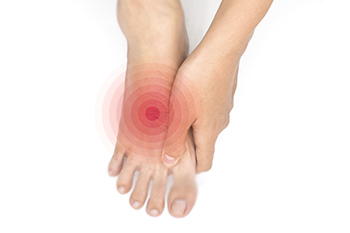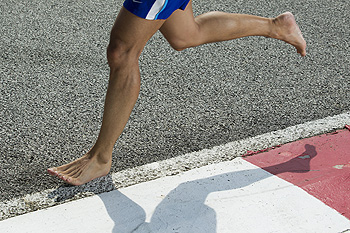March 2023
Foot Care for Diabetic Patients Is Crucial

Practicing good foot care in diabetic patients is crucial in preventing infections from occurring. Diabetes happens as a result of elevated blood sugar levels, and it often affects the feet. It is important to maintain a proper foot care routine, which can be significant in preventing unwanted foot conditions from developing. This can consist of washing and drying the feet daily, followed by inspecting the soles by using a mirror. It can be useful in noticing existing cuts, bruises, or scrapes that have developed, in addition to noticing any skin color changes. It is beneficial to prop the feet up frequently during the day, which may help to improve circulation. Wearing shoes that fit correctly, and refraining from walking barefoot, may aid in protecting diabetic feet. If you have diabetes, it is strongly suggested that you are under the care of a podiatrist who can help you to manage this condition.
Diabetic foot care is important in preventing foot ailments such as ulcers. If you are suffering from diabetes or have any other concerns about your feet, contact one of our doctors from Coral Desert Foot & Ankle. Our doctors can provide the care you need to keep you pain-free and on your feet.
Diabetic Foot Care
Diabetes affects millions of people every year. The condition can damage blood vessels in many parts of the body, especially the feet. Because of this, taking care of your feet is essential if you have diabetes, and having a podiatrist help monitor your foot health is highly recommended.
The Importance of Caring for Your Feet
- Routinely inspect your feet for bruises or sores.
- Wear socks that fit your feet comfortably.
- Wear comfortable shoes that provide adequate support.
Patients with diabetes should have their doctor monitor their blood levels, as blood sugar levels play such a huge role in diabetic care. Monitoring these levels on a regular basis is highly advised.
It is always best to inform your healthcare professional of any concerns you may have regarding your feet, especially for diabetic patients. Early treatment and routine foot examinations are keys to maintaining proper health, especially because severe complications can arise if proper treatment is not applied.
If you have any questions please feel free to contact one of our offices located in St. George and Kanab, UT, and Mesquite, NV . We offer the newest diagnostic and treatment technologies for all your foot and ankle needs.
The Feet Are Complex Structures

The feet carry the weight of the body, and they help to maintain balance. The heels and balls of the feet absorb the majority of the body’s weight. Proper balance can be achieved from the foot and leg muscles that provide stabilizing movements. Each foot consists of 26 bones that are connected by tendons and ligaments, which are part of the foot’s complex structure. The ankle connects the foot and lower leg bones and is divided into two categories, lower and upper ankle bones. The arch is responsible for absorbing impact from walking and similar activities and contains muscles, tendons, blood vessels, and nerves. The arch of the foot is measured in length and width, and there is constant tension as the muscles pull the bones together to create the arch. If you would like to have additional knowledge about the biomechanics of the feet, it is suggested that you confer with a podiatrist who can provide you with the information you are seeking.
If you have any concerns about your feet, contact one of our doctors from Coral Desert Foot & Ankle. Our doctors can provide the care you need to keep you pain-free and on your feet.
Biomechanics in Podiatry
Podiatric biomechanics is a particular sector of specialty podiatry with licensed practitioners who are trained to diagnose and treat conditions affecting the foot, ankle and lower leg. Biomechanics deals with the forces that act against the body, causing an interference with the biological structures. It focuses on the movement of the ankle, the foot and the forces that interact with them.
A History of Biomechanics
- Biomechanics dates back to the BC era in Egypt where evidence of professional foot care has been recorded.
- In 1974, biomechanics gained a higher profile from the studies of Merton Root, who claimed that by changing or controlling the forces between the ankle and the foot, corrections or conditions could be implemented to gain strength and coordination in the area.
Modern technological improvements are based on past theories and therapeutic processes that provide a better understanding of podiatric concepts for biomechanics. Computers can provide accurate information about the forces and patterns of the feet and lower legs.
Understanding biomechanics of the feet can help improve and eliminate pain, stopping further stress to the foot.
If you have any questions please feel free to contact one of our offices located in St. George and Kanab, UT, and Mesquite, NV . We offer the newest diagnostic and treatment technologies for all your foot and ankle needs.
Three Types of Foot Blisters

Blisters are common foot injuries that often result from repeated friction of the toes against the inside of a stiff shoe. A blister formation is actually nature’s way of protecting the skin by separating its layers and allowing fluid to form in between them. This fluid is called serum, which protects the lower layers of skin from damage. Three main types of blisters are friction, blood, and heat blisters. There are a number of ways to prevent blisters, such as keeping your feet dry. This is especially useful for runners, who may need to invest in moisture-wicking socks. Another popular prevention method is to wear shoes that fit properly. They shouldn’t be too small, large, tight, or loose, as any of these conditions can contribute to blister formation. If you frequently notice blisters forming in one or more particular spots, try protecting that area with bandages or other coverings. And finally, when you start to feel a blister coming on, stop the activity. If your blister does not heal on its own or becomes infected, it is suggested that you consult a podiatrist for safe and antiseptic treatment.
Blisters may appear as a single bubble or in a cluster. They can cause a lot of pain and may be filled with pus, blood, or watery serum. If your feet are hurting, contact one of our doctors of Coral Desert Foot & Ankle. Our doctors can provide the care you need to keep you pain-free and on your feet.
Foot Blisters
Foot blisters are often the result of friction. This happens due to the constant rubbing from shoes, which can lead to pain.
What Are Foot Blisters?
A foot blister is a small fluid-filled pocket that forms on the upper-most layer of the skin. Blisters are filled with clear fluid and can lead to blood drainage or pus if the area becomes infected.
Symptoms
(Blister symptoms may vary depending on what is causing them)
- Bubble of skin filled with fluid
- Redness
- Moderate to severe pain
- Itching
Prevention & Treatment
In order to prevent blisters, you should be sure to wear comfortable shoes with socks that cushion your feet and absorb sweat. Breaking a blister open may increase your chances of developing an infection. However, if your blister breaks, you should wash the area with soap and water immediately and then apply a bandage to the affected area. If your blisters cause severe pain it is important that you call your podiatrist right away.
If you have any questions, please feel free to contact one of our offices located in St. George and Kanab, UT, and Mesquite, NV . We offer the newest diagnostic and treatment technologies for all your foot care needs.
Link Between Foot Pain and Obesity

Increased pressure on the feet often happens with obesity. The feet carry the weight of the body, and foot pain may happen from the added weight the feet must endure. Research has shown there is a direct connection between foot and ankle pain and excess body weight. People who are overweight may feel they are in a catch-22, which happens as a result of knowing exercise is helpful in losing weight, and existing foot pain may keep that from being accomplished. The skeletal structure of the foot may be altered in obese patients. The arch may become stretched, and the toes and heels take on extra pressure. Ankle pressure is increased approximately five times while walking up a flight of steps, which may lead to foot conditions such as plantar fasciitis and heel spurs. Weight loss can be done by implementing healthy eating habits into the day’s routine. This can include choosing to eat a variety of fruits and vegetables and trying as best as possible to perform simple exercises. If you have foot conditions that are related to obesity, it is suggested that you consult with a podiatrist who can help answer any concerns you may have.
The more you weigh, the harder your feet must work to support your body. If you’re an obese individual and are concerned about your feet, contact one of our doctors from Coral Desert Foot & Ankle. Our doctors can provide the care you need to keep you pain-free and on your feet.
Obesity and Your Feet
People who are overweight are putting more pressure on their ankles, knees, and hips as well as their feet. This unfortunately can lead to variety of different issues.
Problems & Complications Stemming from Obesity
- When the body is overweight, it tries to compensate by changing the way that it moves. An obese person may lean forward and put extra weight on the wrong part of the foot. This puts unnecessary stress on the feet.
- Obese people are also more likely to develop type II diabetes which is a condition that causes a lot of foot problems. People with diabetes often don’t feel the cuts and sores that they may have on their feet, which can lead to more complicated and severe issues.
- Plantar fasciitis is another foot condition that can be caused by obesity. Plantar fasciitis is an inflammation of the tissue along the bottom of the foot, which causes pain and stiffness while walking and climbing stairs.
If you have any questions, please feel free to contact one of our offices located in St. George and Kanab, UT, and Mesquite, NV . We offer the newest diagnostic and treatment technologies for all your foot care needs.





